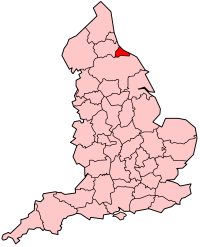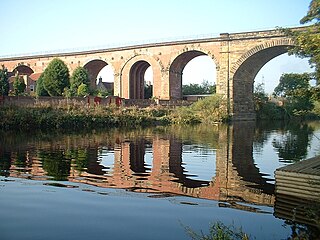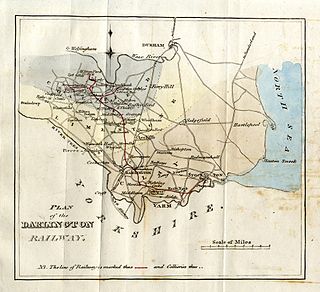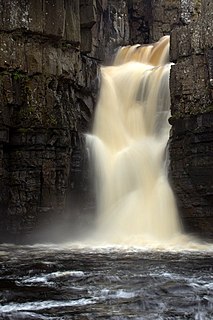
Cleveland is an area in the north-east of England. Its name means literally "cliff-land", referring to its hilly southern areas, which rise to nearly 1,500 ft (460 m). Historically, Cleveland, as a geographic area within the North Riding of Yorkshire, was located entirely to the south of the River Tees and its largest town was Guisborough, until the rise of Middlesbrough in the 19th century.

Yarm is a small town in the ceremonial county of North Yorkshire, England. The town is on the south bank of the River Tees and is historically part of the North Riding of Yorkshire. The bridge at Yarm marked the furthest reach of tidal flow up the River Tees until the opening, in 1995, of the Tees Barrage, which now regulates river flow above Stockton. As the last bridge on the river before the sea, it was superseded by a new toll bridge opened in Stockton in 1771. The oldest part of the town, around the High Street, is situated in a loop of the river, and the newer parts of the town extend to the point where the River Leven meets the River Tees.

The Stockton and Darlington Railway (S&DR) was a railway company that operated in north-east England from 1825 to 1863. The world's first public railway to use steam locomotives, its first line connected collieries near Shildon with Stockton-on-Tees and Darlington, and was officially opened on 27 September 1825. The movement of coal to ships rapidly became a lucrative business, and the line was soon extended to a new port and town at Middlesbrough. While coal waggons were hauled by steam locomotives from the start, passengers were carried in coaches drawn by horses until carriages hauled by steam locomotives were introduced in 1833.

Middlesbrough is a large industrial town on the south bank of the River Tees in North Yorkshire, northeast England, founded in 1830. The local council, a unitary authority, is Middlesbrough Borough Council. The 2011 Census recorded the borough's total resident population as 138,400 and the wider urban settlement with a population of 174,700, technically making Middlesbrough the largest urban subdivision in the ceremonial county of North Yorkshire. Middlesbrough is part of the larger built-up area of Teesside which had an overall population of 376,333 at the 2011 Census.

Teesside is the conurbation in the north east of England around the urban centre of Middlesbrough that is primarily made up of the towns Billingham, Redcar, Stockton-on-Tees, Thornaby and surrounding settlements near the River Tees. It was the name of a local government district between 1968 and 1974—the County Borough of Teesside. Teesside remains an important centre for heavy industry, although the number of people employed has declined. Traditional industries, primarily steelmaking and chemical manufacture, have been replaced to a large extent by high technology activities, science development and service sector roles.

Thornaby-on-Tees is a royal charter town, civil parish and former borough in North Yorkshire, England. Historically part of the North Riding of Yorkshire, Thornaby is situated on the south bank of the River Tees, directly south-east of Stockton-on-Tees and 4 mi (6 km) southwest of Middlesbrough. It has a population of 24,741 according to the 2011 census and is in the unitary authority of Stockton-on-Tees.

The Tees Transporter Bridge, often referred to as the Middlesbrough Transporter Bridge, is the furthest downstream bridge across the River Tees, England. It connects Middlesbrough, on the south bank, to Port Clarence, on the north bank. It is a transporter bridge, carrying a travelling 'car', or 'gondola', suspended from the bridge, across the river in 90 seconds. The gondola can carry 200 people, 9 cars, or 6 cars and one minibus. It carries the A178 Middlesbrough to Hartlepool road. Locally, the bridge is often referred to simply as 'the Transporter'.

Port Clarence is a small village now within the borough of Stockton-on-Tees and ceremonial county of County Durham, England. It is situated on the north bank of the River Tees, and hosts the northern end of the Middlesbrough Transporter Bridge.
The Esk Valley line is a railway line approximately 35 miles (56 km) long from Middlesbrough to Whitby in North Yorkshire, England. The route follows the course of the River Esk for much of its eastern half.

Haverton Hill is an area within the borough of Stockton-on-Tees and ceremonial county of County Durham, England.

Stockton South is a constituency represented in the House of Commons of the UK Parliament since June 2017 by Paul Williams, a Labour MP.

Thornaby railway station serves the town of Thornaby-on-Tees and also much of Stockton-on-Tees. It is located in the borough of Stockton-on-Tees and in the ceremonial county of North Yorkshire. It is currently operated by TransPennine Express.

Stillington is a village within the borough of Stockton-on-Tees and the ceremonial county of County Durham, England. It is situated to the northwest of Stockton-on-Tees.

The Teesdale Way is a long distance walk between the Cumbrian Pennines and the North Sea coast of North Yorkshire in England. The walk is 100 miles (160 km) in length; it links in with other long distance walks such as the Pennine Way and the E2 European Walk between Harwich and Stranraer.

The Tees Barrage International White Water Course, originally the Teesside White Water Course, is an artificial whitewater course on the north bank of the River Tees, in North East England. It is part of the Tees Barrage and is located in the Stockton-on-Tees district, accessible by road only from Thornaby-on-Tees and best accessed by the A66. The course was built in 1995 at a cost of £2m. The course is now open once more under the new name TBIWWC.
The Tees Valley Metro was a project to upgrade the Tees Valley Line and sections of the Esk Valley Line and Durham Coast Line to provide a faster and more frequent service. In the initial phases the services would have been heavy rail mostly along existing alignments. The later phase would have introduced tram-trains to allow street running. The project was backed by all the local authorities through which the system would have run, the authorities are: Darlington, Hartlepool, Middlesbrough, Redcar & Cleveland and Stockton-On-Tees. Support was also forthcoming from the Department for Transport. The project has been cancelled due to lack of funding. Focus is now on Northern Rail franchise. Of the original "Tees Valley Metro" project, only the construction of a new station at James Cook University Hospital has come to fruition.

Middlesbrough bus station serves the town of Middlesbrough, North Yorkshire, England.

The Victoria Jubilee Bridge is a road bridge carrying Bridge Road (A1130) east west across the River Tees between Stockton-on-Tees and Thornaby-on-Tees in the borough of Stockton-on-Tees in the north east of England. Commonly referred to as the Victoria Bridge, it is located just south east of Stockton town centre.

















